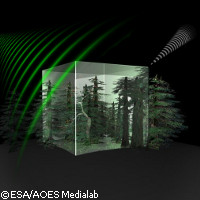Scientists in quest to map boreal forest
The European Space Agency (ESA) recently kicked off a project targeting how to best map the boreal (i.e. northern) forest in northern Sweden. This goal is one of several outlined in the candidate Earth Explorer BIOMASS mission, ESA sources said. Through this mission, the scientists will obtain global measurements of forest biomass to assess terrestrial carbon stocks and fluxes. One of six candidate Earth Explorer missions, BIOMASS recently finalised an assessment study that will be presented to the scientific community next January. ESA said in a statement that three candidate missions will be selected to carry out a feasibility study (i.e. the next development phase), which will help launch the seventh Earth Explorer mission of the ESA. Scientists say the boreal forest, known as Taiga, represents around 15% of the Earth's land surface. Not only does the boreal forest help shape the global cycling of energy, carbon and water, but it also forms a circumpolar band across the northern hemisphere extending from northern Europe and Russia to Canada and the US (specifically the state of Alaska). The Taiga lies north of the deciduous forests and grasslands, and south of the tundra. The ESA said the huge volume of carbon found in the vegetation and soil make the boreal biome (a large naturally occurring community of flora and fauna occupying a major habitat) the biggest terrestrial carbon reservoir worldwide. If the BIOMASS mission is given the green light to continue its work, questions about how much carbon is being stored and where it is located will be addressed, ESA said. The forest biomass is formed of around 50% carbon. The researchers will also try to raise awareness about the global carbon cycle and climate change. In order to map the boreal forest, the researchers will use the longest radar wavelength available for satellites observing Earth from space: P-band. ESA scientists say that this radar wavelength is particularly sensitive to mapping biomass from space. 'The BioSAR 2008 campaign represents the first-ever ESA airborne Synthetic Aperture Radar (SAR) campaign over the northern boreal forest,' remarked Dr Malcolm Davidson, head of ESA's Campaign Unit. 'Because of the importance of boreal forests for the BIOMASS mission, and the global carbon cycle in general, highly accurate and robust methods for transforming the P-band radar signals into forest biomass maps are required,' he added. 'By collecting airborne SAR measurements at P-band over boreal forest and comparing these to extensive measurements made on the ground, we can ensure that the satellite mission will accurately map forest biomass across this unique biome.' The Microwaves and Radar Institute of the German Aerospace Centre (DLR) is using the Experimental Synthetic Aperture Radar (E-SAR) instrument to carry out the campaign in the air. The University of Agricultural Sciences in Umeå, Sweden, supported by both the Swedish Defence Research Agency and Chalmers University of Technology in Gothenburg, are taking ground measurements of key forest characteristics like forest height and biomass. ESA said the growth process for boreal forests is rather slow because of the harsh climate they face. 'When entering some of the forest stands in the test site [...] it is impressive to think how old these trees are,' commented Professor Lars Ulander from Chalmers University. 'Some forest stands are more than 100 years old, so that biomass in such cases is the result of 100 years of growth.'
Countries
Sweden



